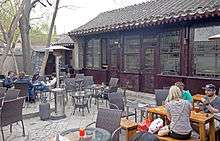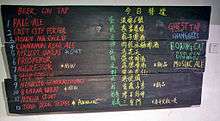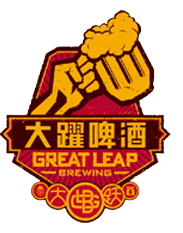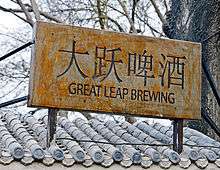Great Leap Brewing
|
Company logo | |||||||||||||
|
Sign at original location | |||||||||||||
| Type | Microbrewery | ||||||||||||
|---|---|---|---|---|---|---|---|---|---|---|---|---|---|
| Location | 6 Doujiao Hutong, Dongcheng District, Beijing, China | ||||||||||||
| Coordinates | 39°56′09″N 116°23′35″E / 39.93593°N 116.39314°ECoordinates: 39°56′09″N 116°23′35″E / 39.93593°N 116.39314°E | ||||||||||||
| Opened | October 2010 | ||||||||||||
| Key people | Carl Setzer, Liu Fang | ||||||||||||
| Distribution | Beijing | ||||||||||||
| Website | http://www.greatleapbrewing.com/ | ||||||||||||
| Active beers | |||||||||||||
| |||||||||||||
Great Leap Brewing (simplified Chinese: 大跃啤酒; traditional Chinese: 大躍啤酒; pinyin: Dàyuè Píjiǔ) operates three brewpubs in Beijing, two in the Dongcheng District and one in the Sanlitun neighborhood of the Chaoyang District. It makes and sells a wide range of beers at those locations, popular both with the city's Western expatriate community and younger Chinese drinkers interested in an alternative product.
When it opened in 2010, it was the first microbrewery in Beijing.[1] Founder Carl Setzer and Dane Vanden Berg, another American expatriate working for an information technology company in Beijing at the time, were frustrated by the narrow choice of beers available in the city. With Liu Fang, Setzer's Chinese wife, they began brewing their own in a former siheyuan on a hutong in the city's Nanluoguxiang neighborhood. That location, still open, has been described as "one of the most difficult bars to find in Beijing."[2]
Eventually they expanded to two other locations, and began offering a range of up to 40 beers at different times of year, with an infusion of venture capital. Setzer left his job to run Great Leap full-time in 2011. The brewery has focused on using Chinese ingredients in its beers, including Sichuan pepper and Tieguanyin oolong tea,[3] and branding that draws on Chinese history and culture, in a successful effort to attract Chinese consumers looking for an alternative to the country's national brands.
History
The founders of Great Leap realized there was a niche for a craft beer in China several years before they started brewing. Once they did, growth was rapid.
2004–2009: Prehistory
| “ | Chinese beers are very light, almost fizzy water, and though you can get imported beers, they don't survive the shipping well. There was clearly a business niche that wasn't being filled. But first we had to learn to brew beer.[4] | ” |
Carl Setzer, a native of Cleveland, Ohio, first came to China in 2004 after graduating from college. He worked at Dongfeng Motor, the country's leading truck manufacturer, in the Hubei city of Shiyan, for a year.[3] There he met and befriended a local woman, Liu Fang, before returning to the U.S. for further study and work.[5]
In 2008 he returned to China, setting up the Beijing office of an American information technology firm. Setzer, who had not been much of a drinker until the previous year,[3] was disappointed with China's national beer brands like Tsingtao. He often complained about them to Dane Vandenberg, a fellow employee back in the U.S. The two realized that Beijing was an ideal market for a microbrewery,[4] much like those that had sprung up in Setzer's native region of Northeast Ohio.[6] "Never let a market that has a requirement go unsupplied," Setzer told CNN later.[3]
Within six months of his return to China, Setzer and Liu had met again, fallen in love and gotten married. the couple traveled to Belgium and the Netherlands, where visits to local breweries helped Liu realize that all beer did not have to taste the same. Back in China, Setzer, whose German great-grandfather had worked at a brewery in Frankfurt, began learning how to make beer,[6] while Vanden Berg, in California, raised money from investors.[4]
The three found an old siheyuan, or courtyard house, on Doujiao Hutong, a narrow side street in central Beijing's Dongcheng District near the Nanluoguxiang area, with many other bars popular with the city's Western expatriate community, and the Bell and Drum Towers, an area popular with younger Beijingers. They began remodeling the turn-of-the-century library[7] for use as a brewpub, keeping the decor to a minimum in order to concentrate on the beer and send that same message to customers.[6] Vandenberg came up with the name "Great Leap" for the risk he and Setzer were taking; the name also alludes to the Great Leap Forward, an ill-fated economic development program launched by Mao Zedong in the mid-20th century.[4]
2010–present: Success and expansion
In October 2010 Setzer finally had enough confidence in his product to open for business. Using ingredients and equipment sourced domestically[8] in order to reduce operating costs,[4] he brewed on Sundays and opened for only the three days before that.[1] The company offered four beers—Pale Ale #6, named for the building's street address; Oatmeal Porter, Cinnamon Rock Candy Ale and Honey Ma Blonde. The latter two used distinctly Chinese flavoring adjuncts to make up for the paucity of Chinese malt varieties: large-bark cinnamon in the former,[3] and a combination of Sichuan pepper and honey from a Shandong apiary run by relatives of Liu's.[6]
Patrons could consume their beer on premises in 330-millilitre (12 imp fl oz; 11 US fl oz) pint glasses, for which they were charged CN¥25–35 depending on the variety. They could also take it home in liter-sized growlers for ¥60–80, or bottles with a ¥30 deposit.[6] All prices were slightly higher than those charged for Chinese national brands at the time.[1] The only food available was spicy peanuts and (sometimes) dried malts; there was no prepared food.[6]
A particular early area of concern for Great Leap was relations with the neighbors in its out-of-the-way residential area. "Strangers in hutongs are never welcome," according to Setzer. To prevent noise complaints, the brewpub closed no later than midnight, and even earlier in summer and during university exam periods.[3]
At first, as Setzer had expected, the clientele was almost exclusively Westerners. Staff at the American and British embassies were early regulars and strong supporters.[4] Initial reviews were positive. "The simple fact is that this place has no gimmicks or frills," wrote the English-language China Daily near the end of the year. "[I]t makes some of the best beer in town."[6]
In January 2011, Setzer quit his job to work at the brewery full-time.[1] "Everyone around me told me I was crazy," he recalled to USA Today later in the year.[5] That spring Vanden Berg came to China to take a more active role in the business.[4] Sales were so strong that by the summer Great Leap was converting a farmhouse near the Great Wall into a brewery to meet demand.[5]
In China and India you have access to spices that would break your budget (elsewhere). But here, they're like a penny for a pound. You can't help but see what works and what doesn't. It's all helped. Chinese customers come in and see the ingredients on the board, and get really curious. The last thing a Chinese customer wants is to feel like they don't know what they're doing. So if they can come in and see that one of our beers is named after a character of the Three Kingdoms, or has spices or a style of tea that they drank when they were kids, it's easier for them, just out of curiosity to pick that one. They don't have to ask a foreigner, or friends, they just say, oh I want to see what that is. Anything with Sichuan peppercorn or tea—they go for that first because they just want to see how that manifests itself in a glass.
– Carl Setzer[9]
As Setzer had hoped, younger Chinese drinkers, many of whom had been introduced to craft beers abroad,[3] were joining the expatriates as customers. By July they were making up 70% of the brewery's customer base. "Some come, they think, 'That's a bit weird,' and leave after one drink," Liu said. "But then they come back the next day, the next week, and bring their friends, too." She observed that, among younger Chinese, the longstanding tradition of consuming alcoholic beverages only in the form of grain-based spirits with meals seemed to be changing thanks to the introduction of beers like Great Leap's.[5]
Setzer continued to expand the available beers, introducing a new one each month on a seasonal basis, and making it a permanent offering if it did well, like a chocolate cardamom stout.[4] "I want to do ever-crazier beers," he said to USA Today. "There are so many different spices and flavors in Chinese cuisine that have not been defined chemically yet."[5]
One of those beers was Iron Buddha Blonde, which uses oolong tea as an adjunct. "[It] gives the beer a floral note at the end," he explained. The name was a play on the name of the tea variety used, tiě guānyīn (铁观音), which means "iron goddess of mercy."[8]
At the other end of the scale was his Little General IPA. As a "purity" beer with only those ingredients allowed by the German Reinheitsgebot (malted barley, hops yeast and water), it had no special flavoring ingredients. But its name came from Zhang Xueliang, a patriotic hero in China and Taiwan. In the late 1930s he kidnapped Chiang Kai-shek, persuaded him to ally his Kuomintang with the Communist forces against the Japanese, then surrendered to Chiang's forces after the kidnapping, to be exiled to Hawaii where he died in 2001 without ever returning to either China or Taiwan. "We take pride in the recipes, names and stories of our products and so far our Chinese customers also take a lot of pride in that," he said later.[8]
Several other bars and a restaurant agreed to sell Great Leap as well. The company made plans to open a second location on Xinzhong Street in the Dongzhimen neighborhood a little further from central Beijing, but more accessible. After it opened, local authorities briefly shut it down over what they claimed was a licensing difficulty (Setzer believes the real issue was that their product wound up outselling Guinness at an Irish bar, which led them to stop that distribution model for a while[10]). But with encouragement from the embassies, they were soon able to reopen. The new facility, which served more food than the original location, proved equally popular, and the three founders were soon going to their investors to raise money for a third site.[4]
By 2012 Great Leap was producing 300 kegs a month, or about 18,000 litres (4,000 imp gal; 4,800 US gal).[1] For that year the company grossed $225,000, of which only a quarter went to operating costs.[3] "I'm living the American dream, just not in America," Setzer observed.[5] The company collaborated with Boxing Cat, a Shanghai craft brewery, to produce Yunnan Amber Ale, which tops off the three different malt and hops varieties each it uses with dianhong black tea from the titular province.[11]
The next year the company opened its third location, in Sanlitun, an area of the Chaoyang District near the U.S. embassy popular for its nightlife. At 530 square metres (5,700 sq ft), it is the largest brewpub in mainland China.[12] With the three locations, Setzer said in 2014 that he expected to be selling a million pints annually. "We're never really satisfied until Great Leap gets to the point that it's available to as many people as possible," he said. "Three strong retail locations in Beijing may accomplish this."[10]
Facilities

Great Leap has three retail outlets at which its beers can be purchased for consumption on or off premises. The oldest, the company's original location, is on Doujiao Hutong in the Dongcheng District near the Bell and Drum Tower and south of the Nanluoguxiang neighborhood. It is a renovated siheyuan, or courtyard house, built to serve as a private library[7] during the final years of the Qing dynasty at the beginning of the 20th century. Beers are brewed and poured in the building, and consumed in the courtyard surrounded by high stone walls. Spiced peanuts are given out for free as snacks.[13]
The original location has also been noted for its seclusion and the challenge of getting there. The Lonely Planet guidebooks describe it as "a hidden gem to beat all hidden gems."[14] Moon's Living Abroad in Beijing strongly suggests reviewing the map from Great Leap's website before visiting for the first time,[15] Wikivoyage calls it "[q]uite possibly the most difficult bar to find in Beijing."[2]
Two other brewpubs are located further to the east, keeping later hours as they are not located in residential areas. Beyond the Second Ring Road but still in Dongcheng, in the Dongzhimen area, is the company's second location on Xinzhong Street. It has more of the features of a typical bar and serves more food.[13] The Sanlitun brewpub, close to the U.S. embassy in the Chaoyang District, is at 530 square metres (5,700 sq ft) the largest such facility in mainland China.[12] The company also operates an offsite brewery in a converted farmhouse in northern Beijing, near the Great Wall of China.
Beers

Great Leap's product range includes 40 beers, of which 12 are on tap in its facilities at any given time, with many varieties produced on a seasonal or rotating basis.[8] All use a variation on the main Great Leap logo, with a graphic on top, Chinese name in large traditional characters in the middle with English below, and circles of varying sizes with the hanzi for "great" and "leap", the latter in its simplified version, flanking a larger one with a monogrammed "GLB" and smaller circles with symbols representing hops and a turret on the Great Wall of China, the latter the location of the company's offsite brewing facility. The English uses a typeface specifically designed for Great Leap's branding. Color schemes vary.[16]
Beers include:
- #6 Pale Ale, named for the street address of the original Doujiao Hutong location.[6]
- Banana Wheat
- Cinnamon Rock Ale, using large-bark cinnamon rock candy as an adjunct.
- Danshan Wheat
- East City Porter.[6]
- Honey Ma Gold, featuring Sichuan pepper as a flavoring adjunct, offset by honey from Shandong.[8]
- Hop God 120
- Imperial Pumpkin, produced every fall
- Iron Buddha Blonde, using Tieguanyin oolong tea as an adjunct, giving a floral finish to the taste.[8]
- Little General IPA, a "purity law" beer named for Zhang Xueliang.[8]
- Liu the Brave Stout, named for Liu's late father. The graphic is based on the one surviving picture of him.[10]
- Mocha Stout
See also
References
- 1 2 3 4 5 Hite, Brittany (February 21, 2012). "Beijing Brews Up Its Own Craft Beers". The Wall Street Journal. Retrieved May 12, 2015.
- 1 2 "Beijing/Dongcheng". Wikivoyage. Retrieved May 15, 2015.
- 1 2 3 4 5 6 7 8 Levine, Jonathan (June 20, 2013). "Beijing's microbrewery boom". CNN. Retrieved May 13, 2015.
- 1 2 3 4 5 6 7 8 9 "One Great Leap". Calvin College. Spring 2012. Retrieved May 13, 2015.
- 1 2 3 4 5 6 MacLeod, Calum (July 12, 2011). "U.S. expatriates pursue American dream in China". USA Today. Retrieved May 13, 2015.
- 1 2 3 4 5 6 7 8 9 Alefounder, Jude (December 2, 2010). "Great leap for Beijing's beer scene". China Daily. Retrieved May 13, 2015.
- 1 2 McCrohan, Daniel (May 20, 2013). "A Chinese Beer Revolution". Men's Journal. Retrieved May 13, 2015.
- 1 2 3 4 5 6 7 McDonnell, Justin (July 23, 2013). "Interview: Great Leap Brewery Founder Taps Into China's Thirst for a Good Microbrew". Asia Society. Retrieved May 13, 2015.
- ↑ Compton, Nick (February 11, 2014). "Talking Their Craft—One Glass at a Time: Beijing's Brewmasters". Hops Magazine. Retrieved May 15, 2015.
- 1 2 3 Furth, D.J. (October 15, 2014). "Great Leap Brewing On Their Brand Philosophy". Creative Hunt. Retrieved May 14, 2015.
- ↑ "Collaboration brews". Boxing Cat Brewery. 2015. Retrieved May 15, 2015.
- 1 2 Hotz, Alexa (January 30, 2014). "On Tap: Beer with Chinese Herbs at Beijing's First Microbrewery". Remodelista.com. Retrieved May 14, 2015.
- 1 2 "Great Leap Brewing". Lonely Planet. 2015. Retrieved May 15, 2015.
- ↑ Lonely Planet China. Lonely Planet. 2013. p. 177. ISBN 9781743216408. Retrieved May 15, 2015.
- ↑ Aitken, Shannon (2013). Moon Living Abroad in Beijing. Moon Publications. p. 147. ISBN 9781612385402. Retrieved May 15, 2015.
- ↑ "Great Leap Brewing". Shift Partners. 2015. Retrieved May 15, 2015.
External links
| Wikimedia Commons has media related to Great Leap Brewing. |

